Physical Address
304 North Cardinal St.
Dorchester Center, MA 02124
Vascular anomalies are divided into vascular malformations and vascular tumors.
The molecular mechanisms that give rise to vascular anomalies involve disordered angiogenesis and vasculogenesis. The most common type of vascular tumor is hemangioma of infancy.
Hemangiomas of infancy (HOIs) are absent at birth, occur in infancy, proliferate until 9 to 10 months of age, and invariably involute or shrink over years.
PHACE ( p osterior fossa intracranial abnormalities, h emangiomas, a rterial abnormalities, c ardiac defects and coarctation of the aorta, e ye abnormalities, with or without associated sternal clefting) syndrome consists of large facial HOIs, ventral clefting, congenital cardiac malformations, intracranial malformations, and ocular abnormalities.
Periocular HOIs can cause deprivation amblyopia and astigmatic amblyopia.
HOIs have unique endothelium that stains with glucose transporter-1 (GLUT-1) immunostain, which distinguishes them from other vascular tumors.
The first-line treatment for hemangiomas is propranolol. It is safe, well tolerated, and effective. Few hemangiomas require surgical treatment.
Rapidly involuting congenital hemangiomas and noninvoluting congenital hemangiomas (NICHs) are histologically identical to HOIs but lack GLUT-1 endothelial staining.
Lymphatic malformations are the most common type of vascular malformation that involves the head and neck.
Lymphatic malformations are classified by stage and by radiographic appearance as macrocystic, microcystic, or a combination of the two.
Lymphatic malformations are low-flow vascular malformations that occur in utero and manifest at birth or in association with an infection or trauma later in life. Most malformations that present at birth or later in life are associated with a normal karyotype.
Low-stage macrocystic lymphatic malformations can resolve spontaneously or can be treated successfully with either surgery or sclerotherapy. In contrast, high-stage suprahyoid lymphatic malformations are difficult to treat with any modality and frequently cause macroglossia. Suprahyoid microcystic malformations that involve oral and oropharyngeal mucosa have been associated with lymphocytopenia and recurring inflammation. Sirolimus may be a viable option for these patients.
Venous malformations are associated with tyrosine-kinase type 2 receptor dysfunction, which causes abnormal venous structure. Histologically, venous malformations can be a combination of both blood vasculature and lymphatic vasculature.
Kasabach-Merritt phenomenon is most commonly associated with the vascular tumors kaposiform hemangioendothelioma (KHE) and tufted angioma (TA).
Arteriovenous malformations (AVMs) are high-flow malformations that can occur in any area of the head and neck; they are treated with a combination of embolization and surgical therapy.
The authors would like to acknowledge Dr. Logan Dance, Interventional Radiologist, and Dr. Kevin Moore, Pediatric Neuroradiologist, for their expertise and images.
Vascular anomalies have abnormal blood and lymphatic vasculature, and 80% occur in the head and neck. Usually, clinical and radiographic findings, and occasionally histologic evidence, are used to distinguish among various vascular anomaly subtypes. These lesions may cause unique systemic and local effects, presenting in various ways. A vascular anomaly classification system has been developed based on these factors ( Table 25.1 ). , In this classification scheme, vascular anomalies are separated into vascular tumors and vascular malformations. The initial division into these categories reflects the careful analysis of the natural clinical history of cutaneous hemangiomas of infancy (HOIs), which are absent at birth, appear during early infancy, and grow rapidly within the first year of life. After this proliferative phase, a variable period of shrinkage or involution occurs, a pattern that distinguishes HOIs from vascular malformations. These astute clinical observations have opened the possibility of further separating blood and lymphatic-derived tumors into individual groups to allow more accurate diagnosis and treatment. Numerous discoveries have further solidified the distinction between vascular tumors and vascular malformations.
| Vascular Anomalies | ||||
|---|---|---|---|---|
| Vascular Tumors | Vascular Malformations | |||
| Benign | Locally Aggressive | Malignant | Simple | Combined |
| Infantile hemangioma | Kaposiform hemangioendothelioma | Angiosarcoma | Capillary malformation (C) | CVM, CLM |
| Congenital hemangioma | Retiform hemangioendothelioma | Epithelioid hemangioendothelioma | Lymphatic malformation (LM) | CLM, CLVM |
| Tufted hemangioma | Papillary intralymphatic angioendothelioma (PILA), Dabska tumor | Venous malformation (VM) | CAVM | |
| Spindle-cell hemangioma | Composite hemangioendothelioma | Arteriovenous malformation (AVM) | CLAVM | |
| Epithelioid hemangioma | Kaposi sarcoma | Arteriovenous fistula | ||
| Pyogenic granuloma | ||||
Currently, vascular tumors are thought to represent disordered vascular development, although they demonstrate certain neoplastic characteristics. , Most vascular tumors are benign, but some can be malignant. Radiographically, these tumors can be characterized in terms of lesion size, blood flow, and location ( Fig. 25.1 ). , Certain conditions such as profound thrombocytopenia (Kasabach-Merritt phenomenon) are associated with vascular tumors but not vascular malformations. , Additionally, some vascular tumors are associated with known syndromes, such as PHACE ( p osterior fossa intracranial abnormalities, h emangiomas, a rterial abnormalities, c ardiac defects and coarctation of the aorta, e ye abnormalities, with or without associated sternal clefting).
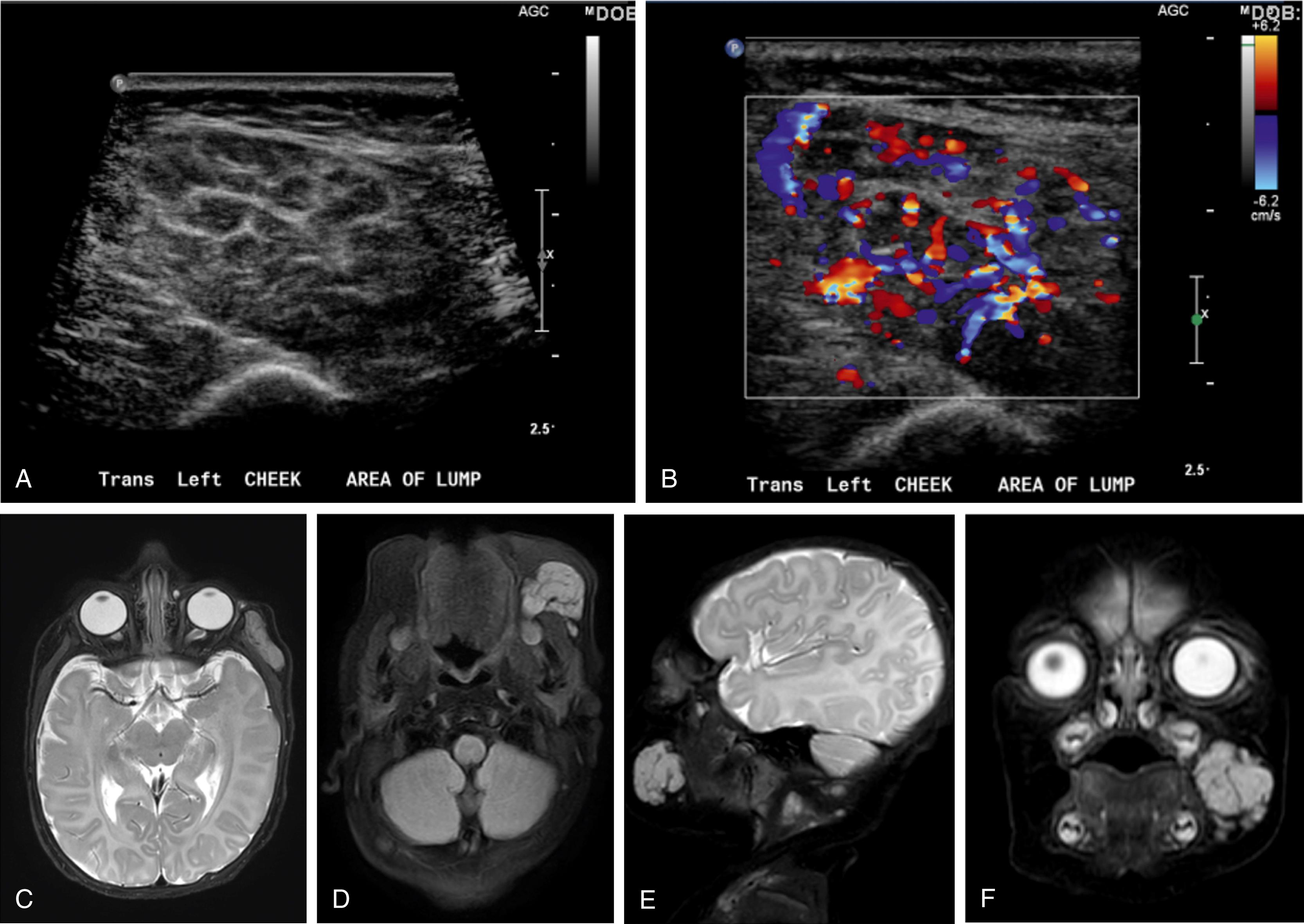
Vascular malformations have been described in lesions that contain all vessel types: arterial, venous, and lymphatic. It remains to be proven that vascular malformations represent an early embryonic disorder in vasculogenesis. , , Some vascular malformations have been associated with genetic defects, especially those with tissue overgrowth. In contrast to vascular tumors, most vascular malformations are present at birth and demonstrate growth parallel to the individual’s growth. These lesions have a distinct radiographic appearance in their location, size, and intralesional blood flow. Additionally, radiographic architecture is useful to characterize vascular malformations, especially lymphatic malformations, which are also associated with either local tissue or bony overgrowth ( Fig. 25.2 ). Since the original distinction of HOIs from other types of vascular tumors and malformations, molecular characteristics and radiographic features have allowed further distinction between various subtypes. These distinctions have guided treatment and led to better outcomes.
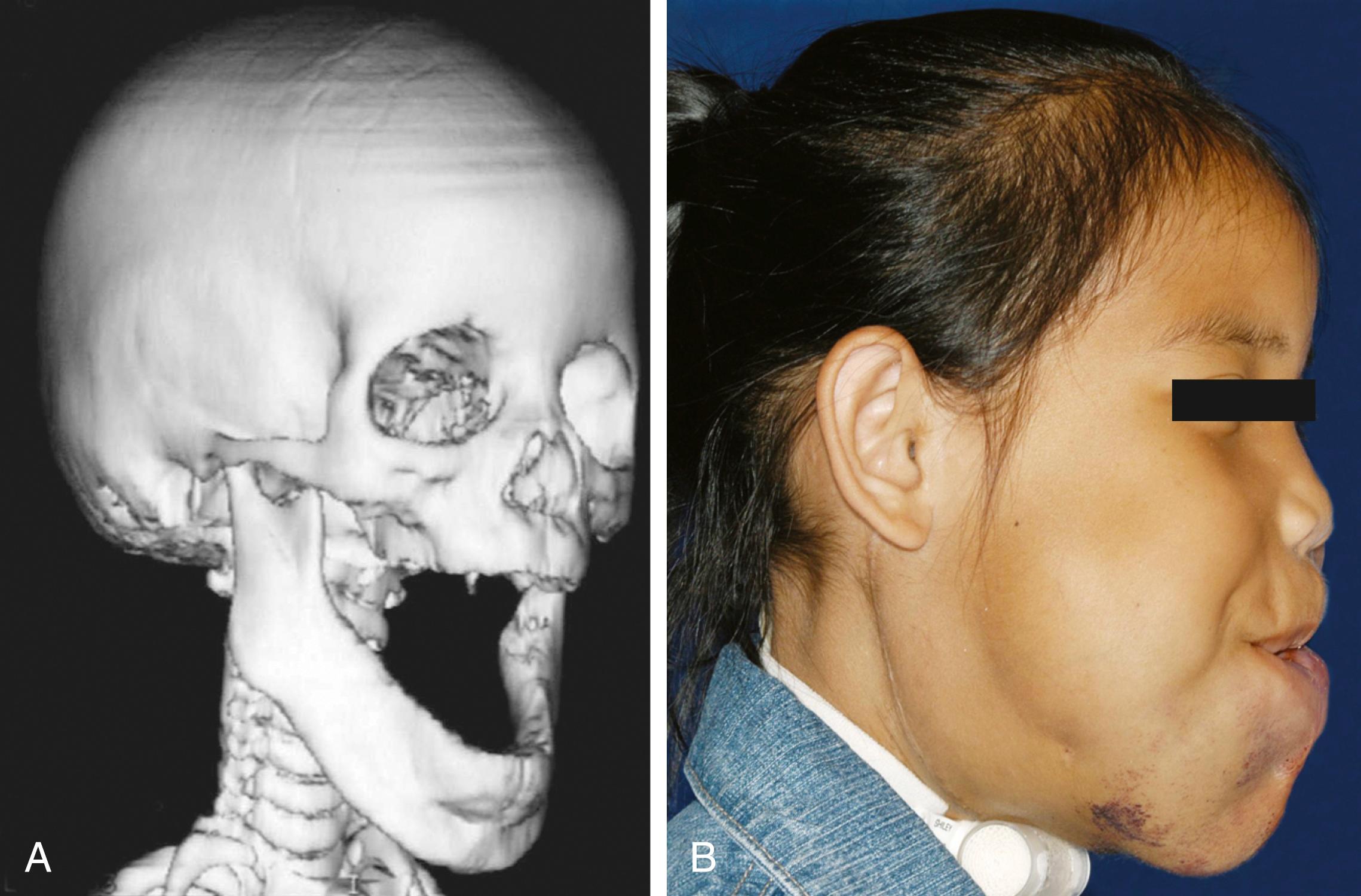
The genetic and molecular basis for some vascular anomalies are being investigated. , , , Inherited venous malformations are associated with mutations in the TEK gene, which encodes the protein receptor for tyrosine kinase, also known as Tie2, which plays a role in endothelial–smooth muscle communication essential for venous morphogenesis. Venous malformations have defects in the smooth muscle layer of vessels that are thought to result from this mutation. Similarly, vascular anomalies that occur in hereditary hemorrhagic telangiectasia types 1 through 3 have been associated with mutations in genes that mediate endothelial function. Familial HOIs have been identified through pedigree analysis. Arteriovenous malformations (AVMs) that occur in conjunction with atypical capillary malformations have been linked to a potential candidate gene, RASA1. Hypertrophy of tissues near vascular malformations has been linked to mutations in the PTEN tumor-suppressor gene and others. , Understanding the molecular mechanisms behind the pathogenesis of vascular anomalies opens the door for new treatment options.
HOIs are absent at birth and appear in infancy; they then proliferate for 6 to 9 months and involute partially or completely over several years ( Fig. 25.3 ). , Alternative diagnoses should be considered for vascular lesions that do not follow this pattern. HOI can be further confirmed through molecular staining and sophisticated imaging characteristics. , HOI endothelium has several unique surface markers that can be detected by immunohistochemistry. Detection of glucose transporter-1 (GLUT-1) in HOI endothelium distinguishes them from other vascular anomalies. On ultrasound, HOI will demonstrate characteristic high vascularity on Doppler imaging (see Fig. 25.1A–B ). Magnetic resonance imaging (MRI) can be helpful in differentiation of HOIs from other vascular anomalies (see Fig. 25.1C–F ). , , Computed tomography (CT) scanning has a more limited role in the diagnosis of vascular anomalies and potentially exposes patients to unnecessary radiation.
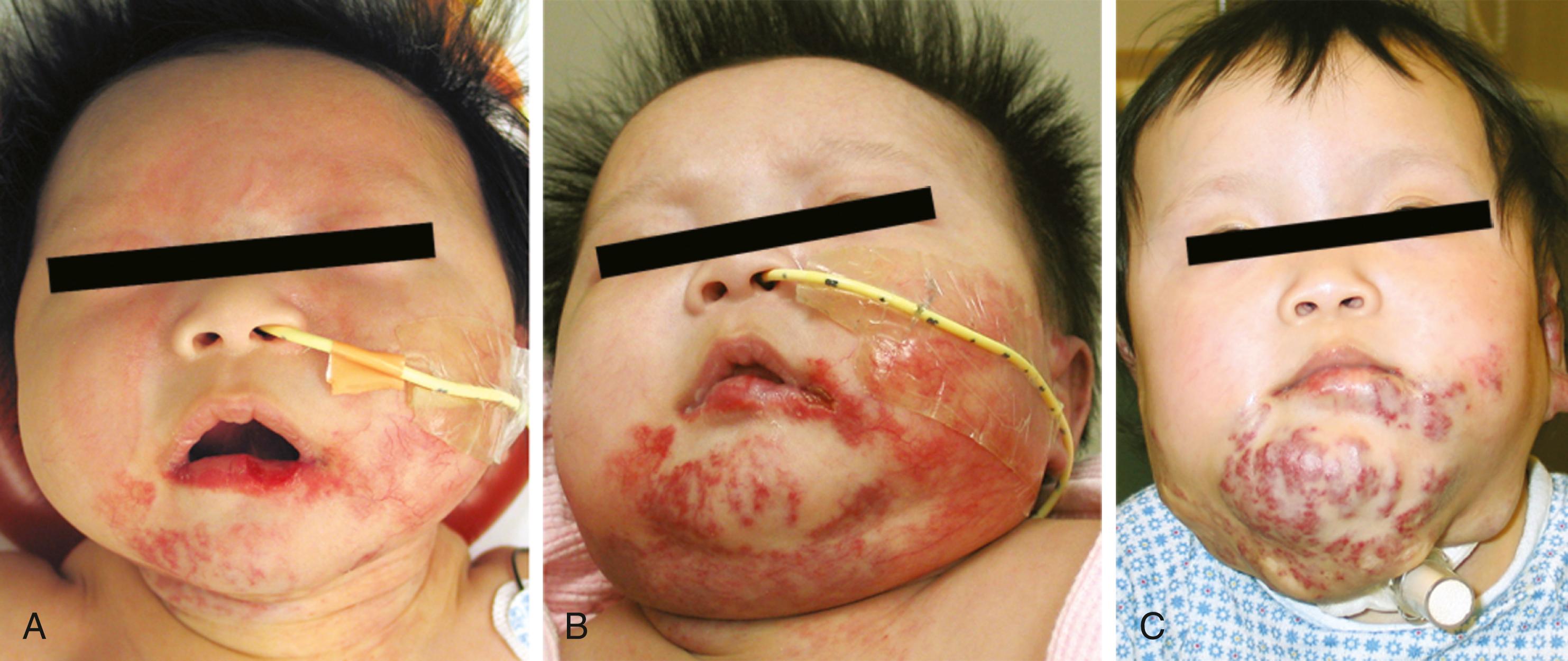
At birth, HOIs can be completely absent or present as a slight redness or pallor. In the first several months of life, the hemangioma grows rapidly and can involve any part of the body. Two thirds of such lesions occur in girls, and HOIs are more prevalent in premature infants, those born to mothers of advanced maternal age, mothers with a history of chorionic villous sampling, and in the presence of placental anomalies. A hereditary component is suggested by increased recurrence risk in siblings and pedigrees with multiple affected family members ( Fig. 25.4 ). , Segmental HOIs are usually superficial, variably involve cutaneous dermatomes, and have more associated morbidity than focal HOI. Head and neck segmental lesions are hypothesized to occur in embryologic prominences related to neural crest cells and their influence on vascular development ( Fig. 25.5 ). In contrast, head and neck focal HOIs occur in identifiable patterns thought to be associated with lines of embryonic tissue fusion. , , Building on the concept of embryonic fusion planes, several groups have observed that midface HOIs do not predictably involute. It is believed that the HOI “footprint” is set by 4 months of life and that residual growth occurs in lesion thickness, not size.
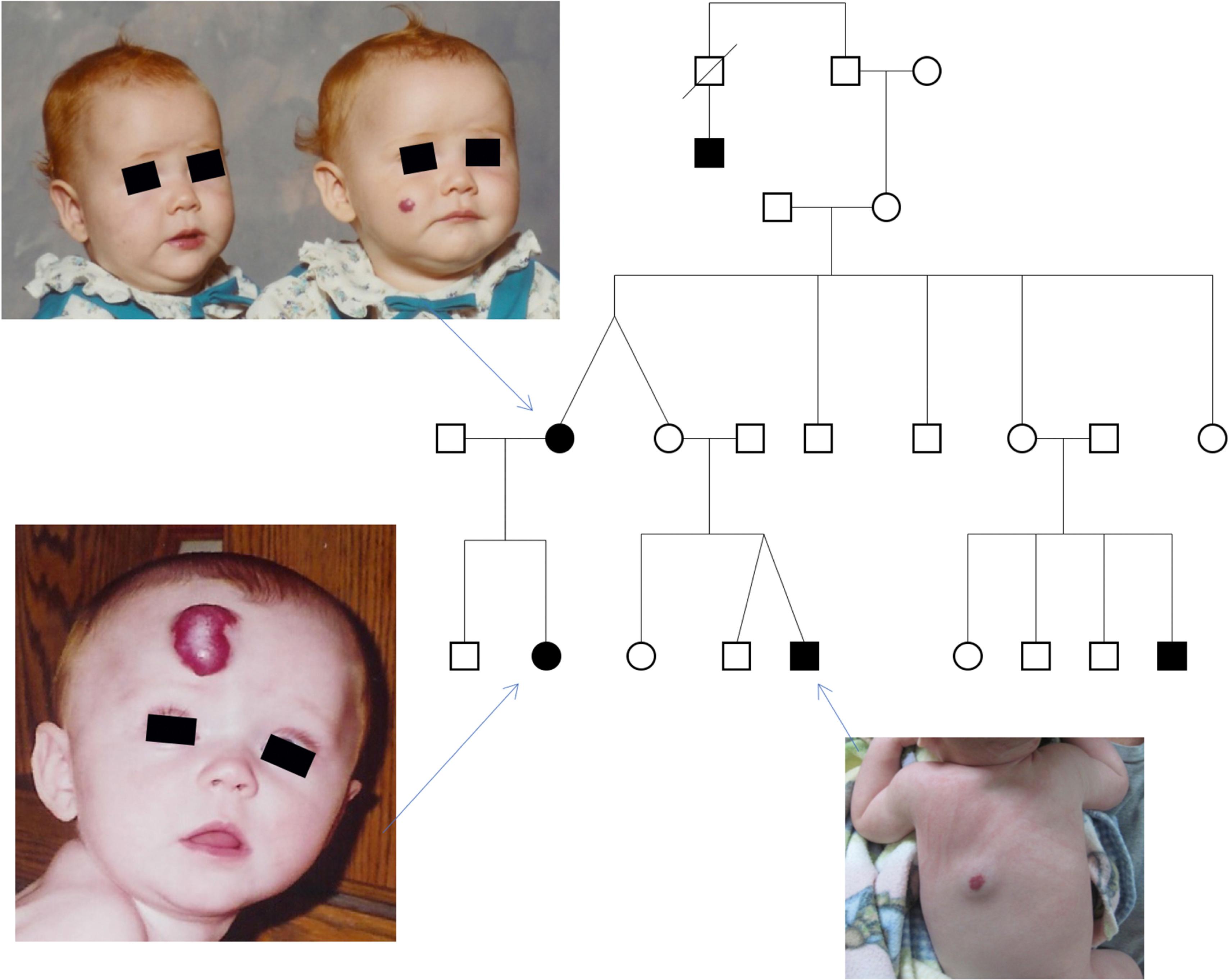
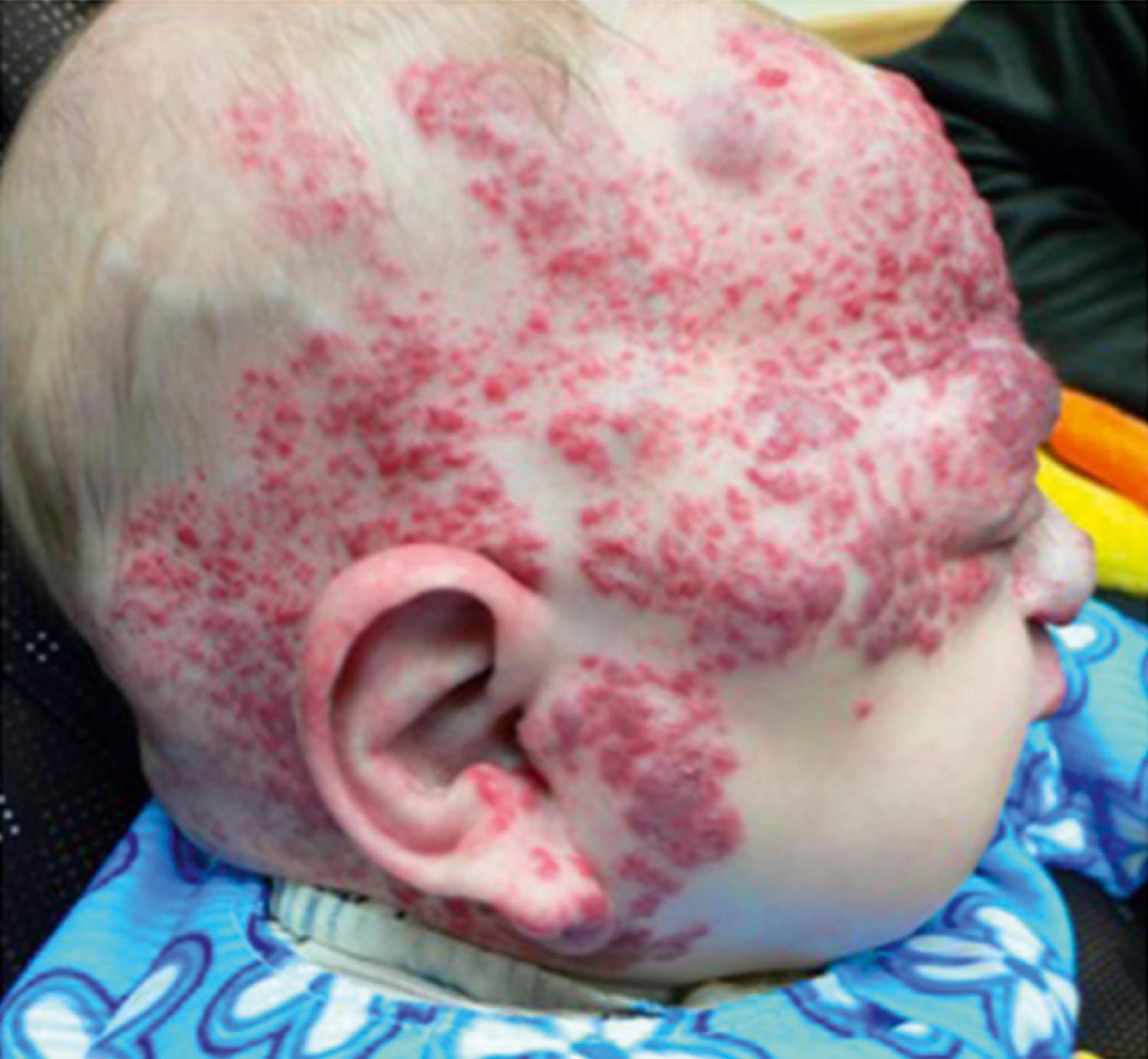
An association between some HOIs and ventral clefting, congenital cardiac malformations, intracranial malformations, and ocular abnormalities has been described ( Fig. 25.6 ). PHACE syndrome (or PHACES syndrome; s ternal clefting is at times included [sometimes with other ventral clefting abnormalities]). Central nervous system symptoms include developmental delays, seizures, and congenital stroke. Patients with a large segmental hemangioma or facial hemangioma larger than 5 cm should be worked up for PHACE syndrome. Suspected PHACE patients should undergo head imaging, ophthalmologic examination, and cardiac evaluation. Rarely, PHACE syndrome can be associated with cranial neuropathies, such as facial nerve palsy and rarely with cerebellopontine angle lesions, resulting in hearing loss. Some recommend antiplatelet therapy for patients with abnormal cerebral vasculature to prevent congenital stroke. , Further analysis of HOI biology is necessary to understand these associations. Of note, a significant number of PHACE patients have airway HOIs.
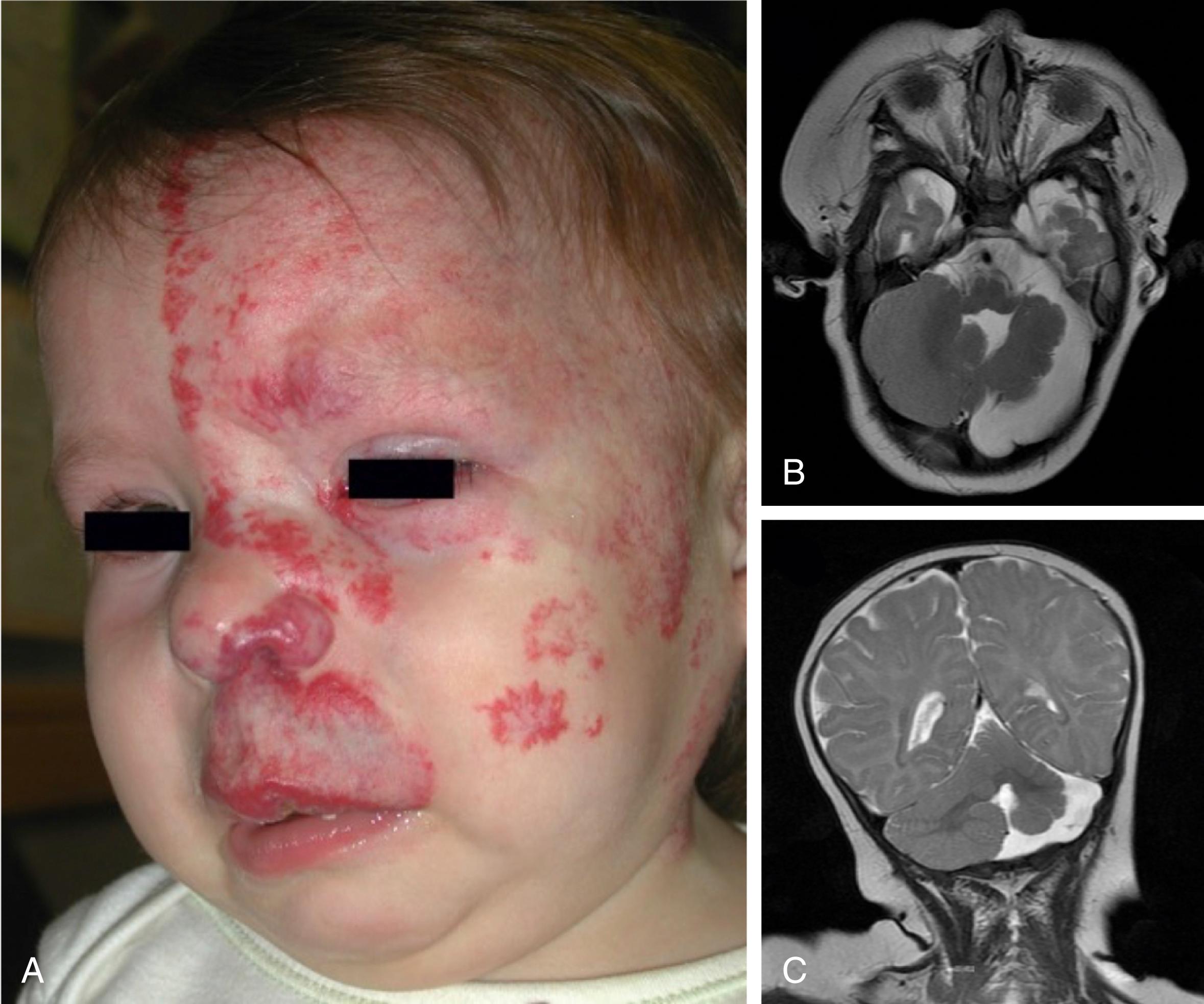
Congenital hemangiomas are high-flow vascular tumors that are present at birth and are histologically similar to HOI, except for the absence of GLUT-1 staining in congenital lesions. , There are two types of congenital hemangiomas: those that rapidly resolve over the span of a year and those that persist. For this reason, they are named rapidly involuting congenital hemangioma (RICH) or noninvoluting congenital hemangioma (NICH), respectively. These lesions are often difficult to distinguish from HOIs unless a careful history is taken and histologic analysis performed. Often, the diagnosis remains uncertain until its clinical behavior can be observed ( Fig. 25.7 ). Medical therapy is ineffective for congenital hemangiomas. Treatment for RICHs is usually observation, whereas NICHs may require laser or surgical therapy.
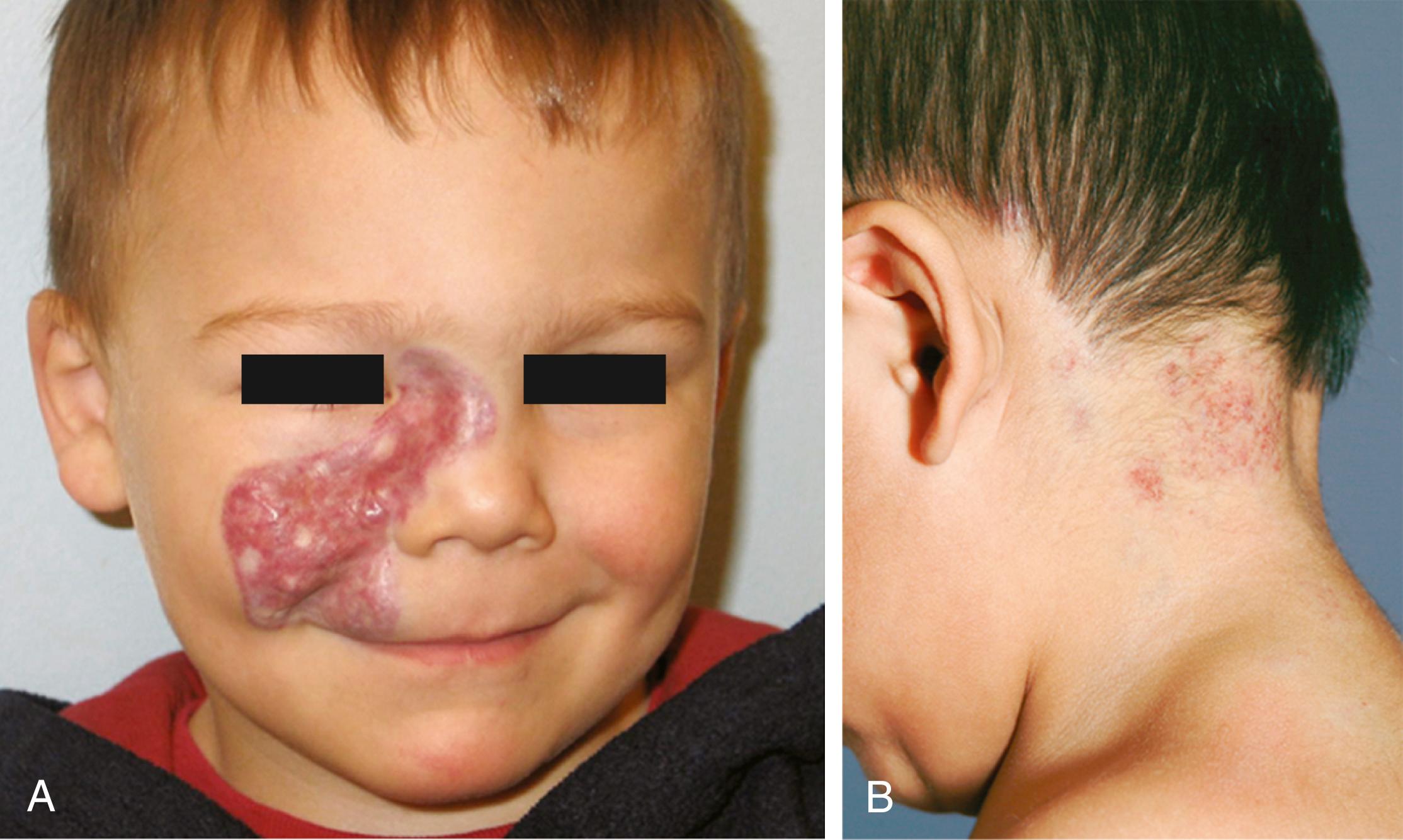
Most nonhemangioma vascular tumors are benign and rarely occur in the head and neck. The two most common are kaposiform hemangioendothelioma (KHE) and tufted angioma (TA). KHE occurs anywhere in the head and neck and has a significant lymphatic component in addition to blood vascular endothelium. KHE appears clinically as violaceous cutaneous nodules that extend into deep tissues ( Fig. 25.8 ) and radiographically as a diffuse infiltrative vascular process (see Fig. 25.8 ). TAs are more localized than KHE and may or may not involve the skin. Treatment of both KHE and TA is centered on proper diagnosis, prevention of complications, and tumor control. Treatment must be individualized, as the natural history of these lesions is often unclear. Diagnosis requires an incisional biopsy with possible immunohistochemical staining. Curative surgical resection is possible and is advisable in some localized tumors, but for large lesions, complete resection may not be possible. In extensive KHE or TA that causes pain, loss of function, or significant disfigurement, antiangiogenic chemotherapy may be necessary. Sirolimus, or rapamycin, was initially trialed in refractory KHE for compassionate reasons, and has been found to be effective in other vascular anomalies as well. ,

Most complications occur in HOIs, because it is the most common vascular tumor. HOI complications are related to functional compromise and cutaneous ulceration associated with rapid proliferation. Subglottic HOIs cause biphasic stridor by narrowing the infant’s airway, presenting as respiratory distress ( Fig. 25.9 ). Visual axis obstruction by proliferating HOIs occurs with eyelid lesions and may induce deprivation amblyopia ( Fig. 25.10 ). Eye deformation secondary to a lesion compressing the eye or distorting periocular tissue before 6 months of age induces astigmatic amblyopia. Proliferating HOIs in places of repetitive skin trauma, such as the lips and neck skin folds, can ulcerate and result in scarring ( Fig. 25.11 ). The reasons for ulceration are unclear, but, when present, ulcerations begin as brown crusts that become painful and bleed, requiring local wound care for healing. Extensive HOI ulcerations can become infected and result in tissue loss, which further complicates healing and treatment ( Fig. 25.12 ). Lip ulceration makes oral feeding challenging because of pain and lip distortion. Large head and neck HOIs that involve the parapharyngeal and scalp regions are often associated with high-output cardiac failure from increased blood flow. The psychosocial consequences of HOIs on the family and patient are important to consider in treatment planning.
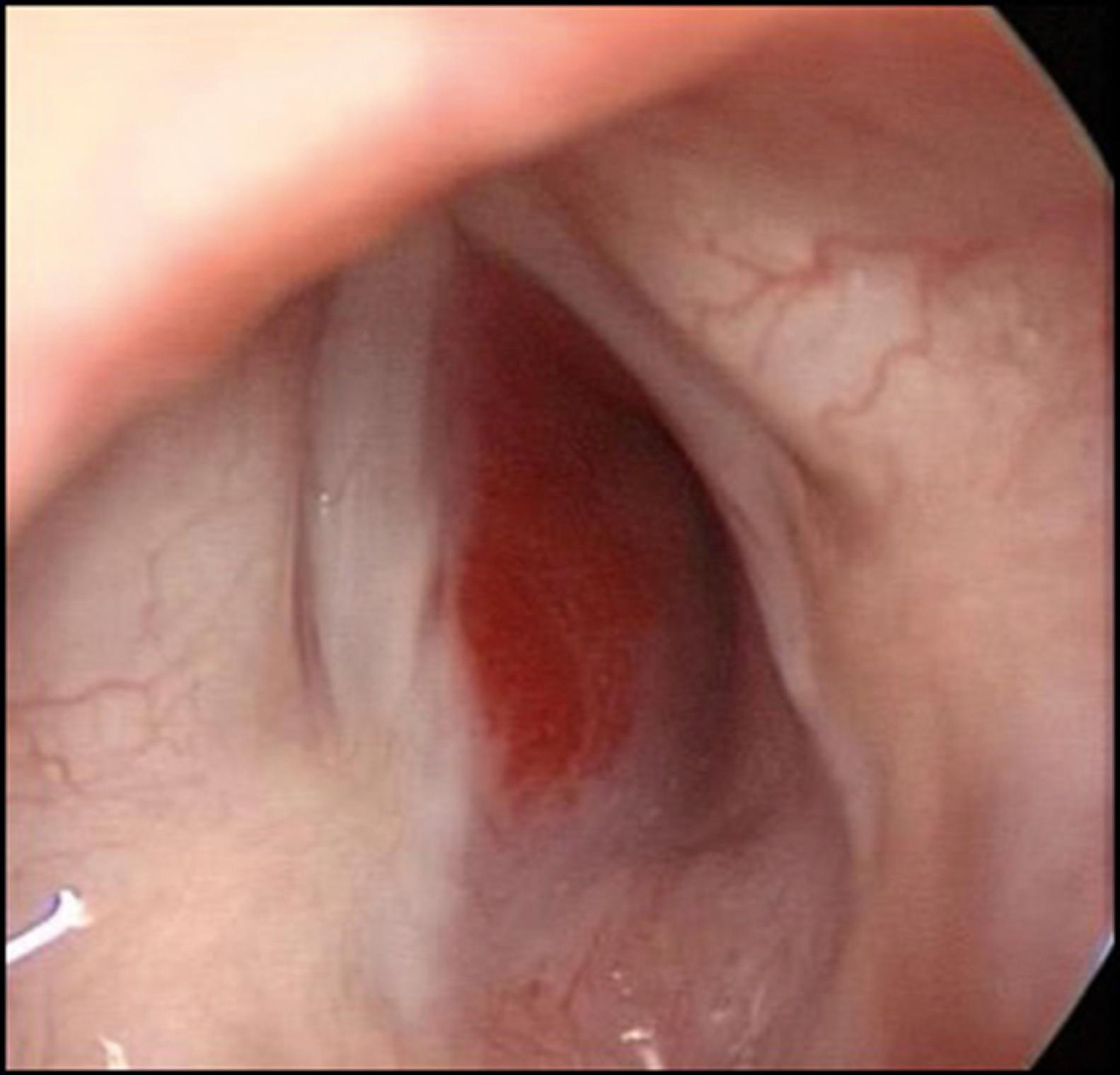
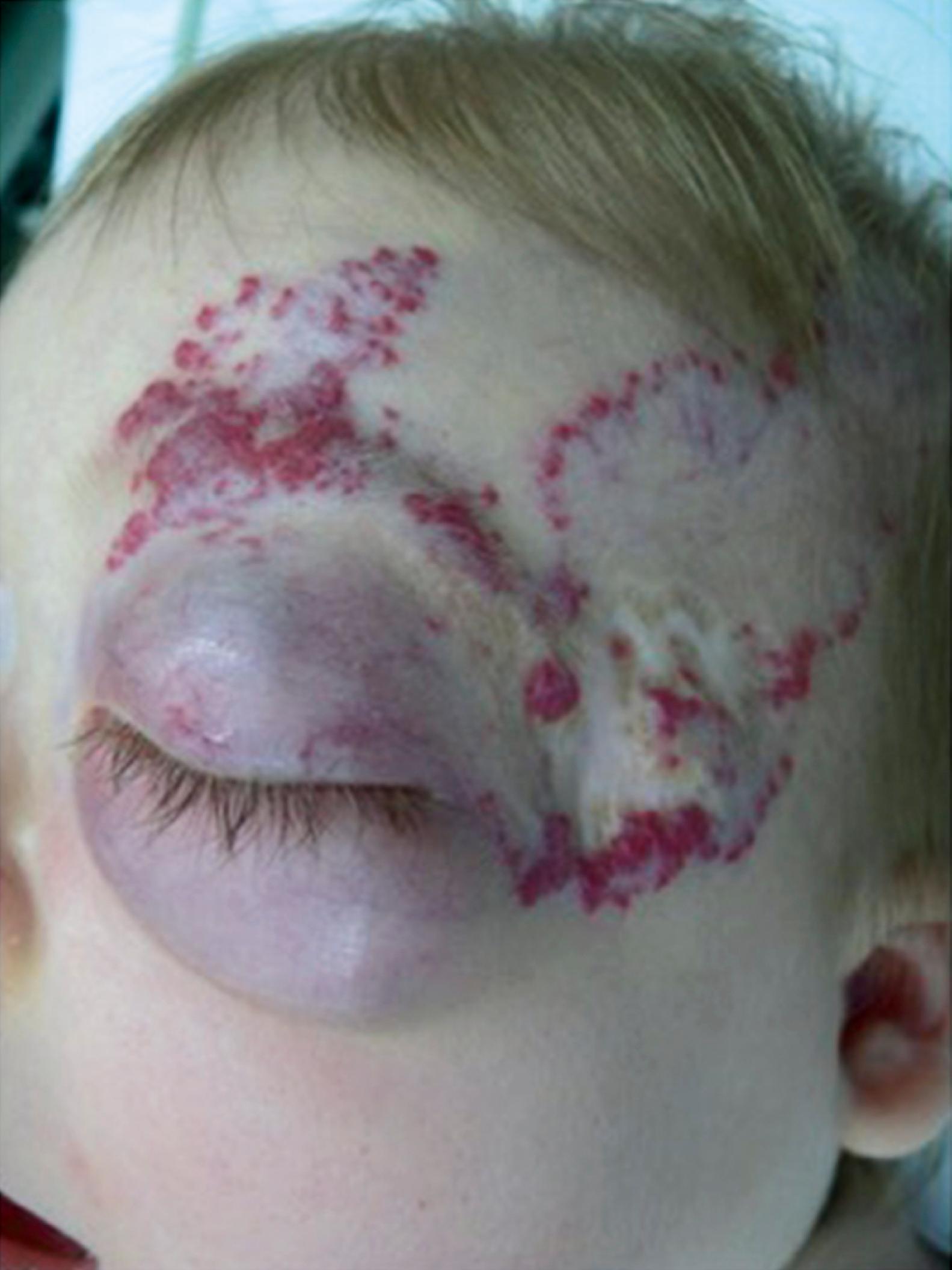
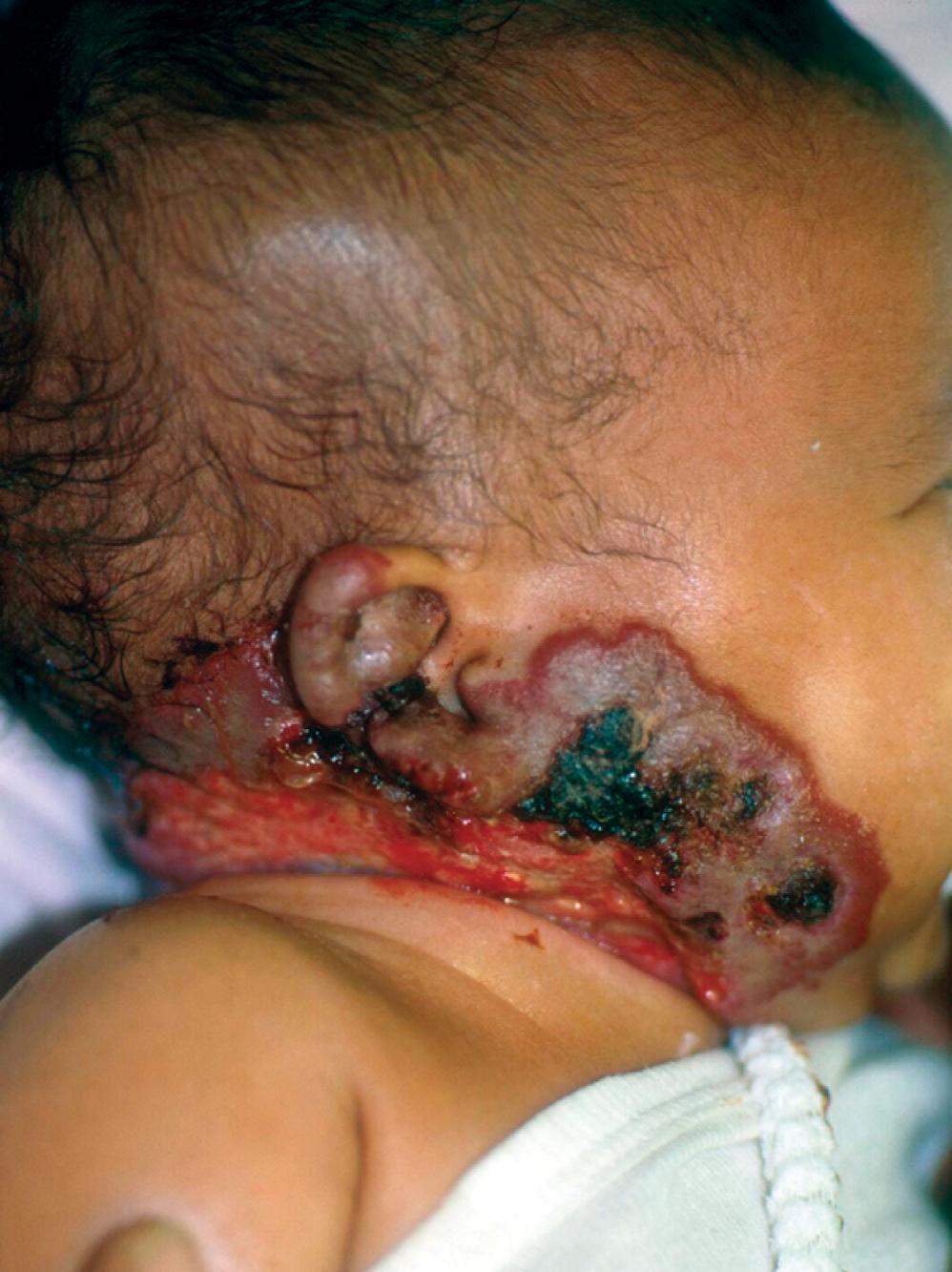
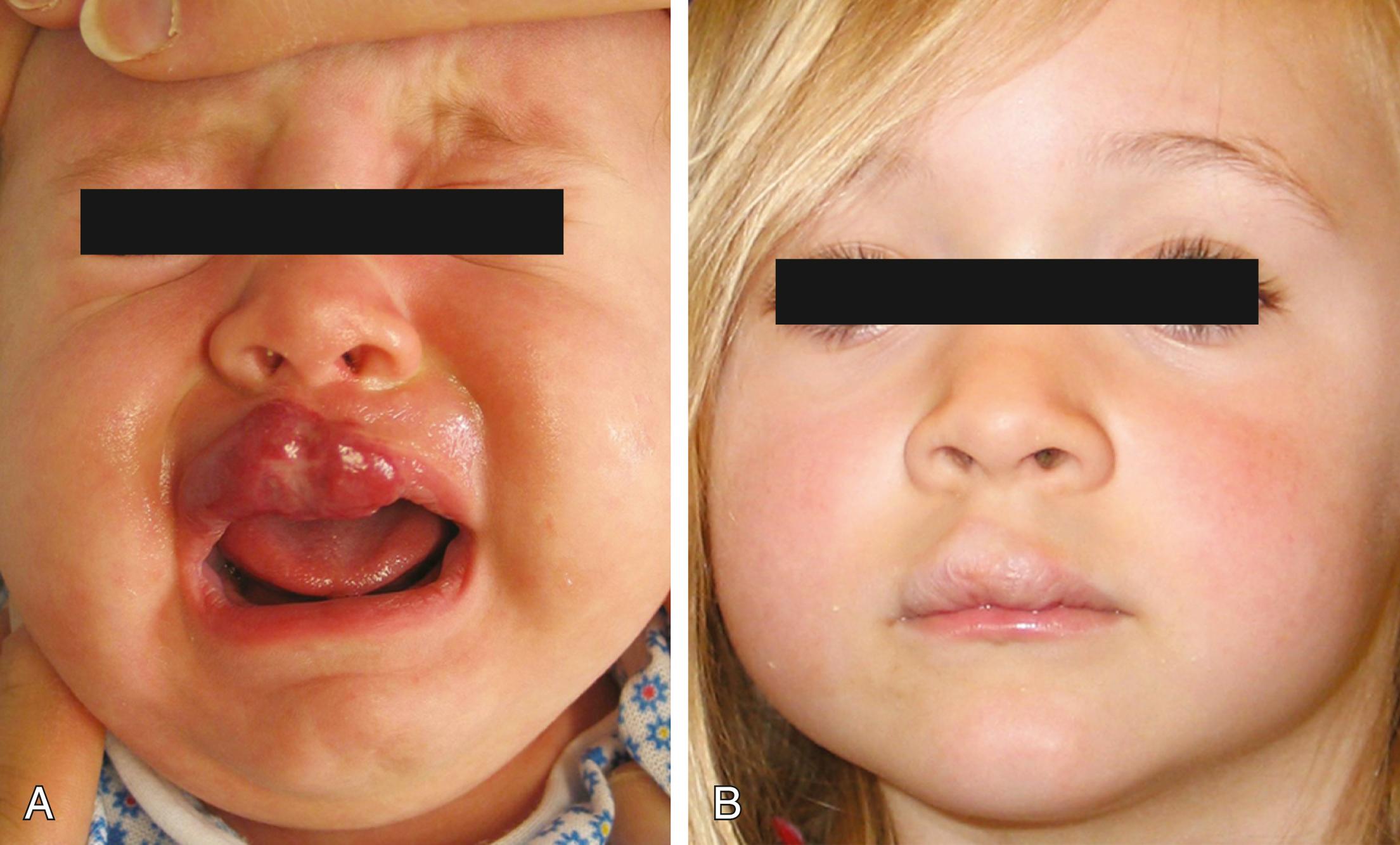
Become a Clinical Tree membership for Full access and enjoy Unlimited articles
If you are a member. Log in here